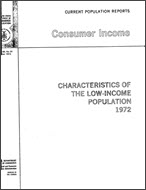Characteristics of the Low-Income Population: 1972
Characteristics of the Low-Income Population: 1972
This report presents social and economic statistics for the population of the United States below the low-income level/1 in 1972, based on the March 1973 Current Population Survey (CPS). Included are data on selected characteristics of the population below the low-income level in 1972, such as geographic distribution, residence in low-income areas, race and ethnic origin, family status, size of family, education, employment status, work experience, occupation, income (including type and source), and income deficit. Several historical tables detailing a picture of the changing composition of the population below and above the low-income level since 1959, the first year for which low-income data are available, are also presented. A description of the population below the low-income level in 1972 and some analysis of changes in the composition of this population over the past year and since 1959 are included. In this text, the terms "low-income", "poverty", and "poor" are used interchangeably.
In 1972, there were 24.5 million persons below the low-income level, comprising 12 percent of the United States population (Table 1). The number of low-income persons declined by 4 percent between 1971 and 1972 and by 38 percent between 1959 and 1972. The decrease of 1.1 million persons over the past year represented the first statistically significant decrease since the 1968-69 period. The number of low-income white persons declined by about 9 percent between 1971 and 1972, and there was some evidence of an increase in the number of low-income blacks. Over the same period, there was a 13 percent decrease in the number of low-income persons 65 years old and over and no significant change for those under 65 years. While the number of low-income families declined at about the same rate as the number of low-income persons over the past year and between 1959 and 1972, the number of low-income unrelated individuals (persons living alone or with nonrelatives) was lower in 1972 than in 1971, but the sampling error was too large to measure whether there was any change since 1959. There were 5.1 million families and 4.9 million unrelated individuals below the low-income level in 1972. For a more detailed discussion of changes over time, see page 10.
__________
/1 Families and unrelated individuals are classified as being above or below the low-income or poverty level, using the poverty index adopted by a Federal Interagency Committee in 1969. This index is based on the Department of Agriculture's 1961 Economy Food Plan and reflects the different consumption requirements of families based on their size and composition, sex and age of the family head, and farrn-nonfarrn residence. In order to keep the poverty index constant over time, the thresholds are updated annually based on changes in the Consumer Price Index. The low-income threshold for a nonfarrn family of four was $4,275 in 1972, $4,137 in 1971, and $2,973 in 1959. See page 141 for a detailed explanation of the low-income definition.
A Note on Language
Census statistics date back to 1790 and reflect the growth and change of the United States. Past census reports contain some terms that today’s readers may consider obsolete and inappropriate. As part of our goal to be open and transparent with the public, we are improving access to all Census Bureau original publications and statistics, which serve as a guide to the nation's history.
Others in Series
Publication
Publication
Publication




